The front of your house is the first thing people see when they arrive, therefore it is the best thing to make a good impression. One way to enhance your home’s front yard appeal is by adding evergreen shrubs to it.
Not only do they provide year-round color and structure, but they also offer privacy and can increase your property’s value. In this comprehensive guide, you will learn about the top 20 evergreen shrubs that are perfect for the front of your house.
List of evergreen Shrubs
- Boxwood
- Azalea
- Siberian Carpet Cypress
- Juniper
- Rosemary
- Arborvitae
- Colorado Blue Spruce
- Inkberry
- Griselinia
- Holly
- Mugo pine
- Yew shrub
- Camellias
- Rose Mallow
Facts And Characteristics
Boxwood
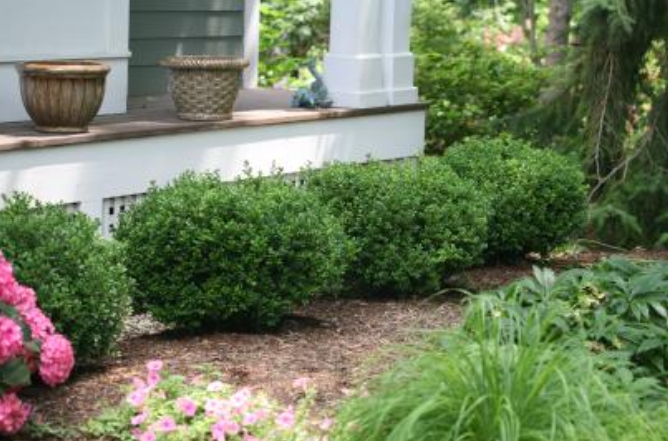
In places like North America, Boxwood is the most popular evergreen shrub used for front yard landscaping. This is actually for a good reason. Boxwood has dense, green foliage and be pruned into various shapes, including topiaries, hedges and globes. Even some varieties have variegated leaves.
Boxwood shrubs remain popular and decorate the formal gardens of some of the world’s most famous landmarks including Versailles, Mount Vernon and the White House.
Though boxwood shrubs are slow growing, most of them with time can reach up to six feet tall and thus able to fit in landscapes of all sizes and styles. Some even can remain just under two feet tall. Boxwood is easy to care for, is highly tolerant of different soil types and can withstand a range of weather conditions.
This shrub for example, can be planted in a row to create a classic hedge, or it can be arranged in different shapes and sizes to create a unique topiary. It is also good for creating a low border around flower beds or as a backdrop for colorful annuals.
Facts And Data
| Scientific Name | Buxus |
| Number of Species | Over 90 |
| USDA Hardiness Zones | 5-9 |
| Size | 1 to 12 feet or more |
| Best Uses | Classic hedges, topiaries, Borders, Accent planting and foundation planting. |
Azaleas
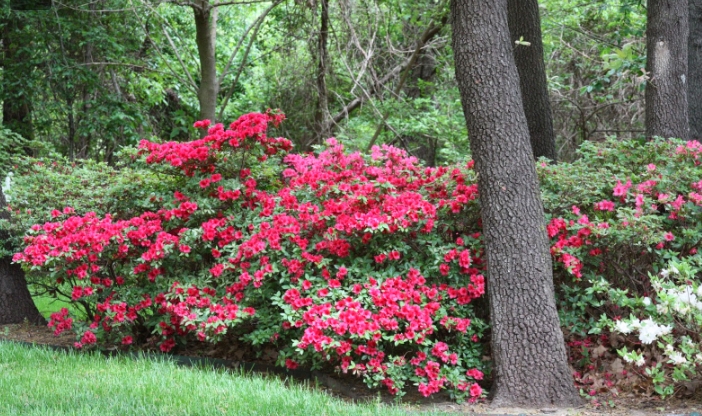
Azaleas can work well as front yard shrubs. Their vibrant blooms add a burst of color and unlike many other shrubs that lose their leaves in the winter, azaleas keep their foliage year-round. They come in a range of colors, including pink, red, purple and white. Their blooms last for several weeks in the spring and summer.
Azaleas can be used in a variety of ways to enhance the appearance of your front yard. They can be planted in rows to create a hedge, or they can be mixed with other plants. They can also be used for accent planting and to enhance areas such as entryways or patios in your front yard.
Azaleas are low-maintenance and can be grown in different soil types, although they prefer acidic soil with good drainage. They also should be watered regularly, especially during dry spells. Some varieties are adapted to warmer or colder climates.
Azaleas can be seen brightening very many home gardens along Pacific coastal regions of the United States, in the south and colder regions. There are over 10000 registered hybrids of Azalea, according to the Azalea Society of America.
Facts And Data
| Genus | Rhododendron |
| Number of Species | Over 10000 |
| Size | 1 to 12 feet tall |
| USDA Hardiness Zones | 6 to 8 |
| Native Area | North America and Asia |
Siberian carpet cypress

Siberian carpet cypress, also known as Microbiota decussata, is a low-growing evergreen shrub that is native to Siberia and Northeast Asia.
It is indeed a good shrub for front yards for a number of reasons. It has a low-growing habit and more importantly has an attractive green foliage. It is also drought-resistant and can tolerate periods of dry weather.
This shrub grows to a height of only 6 and 12 inches, but can spread up to 6 feet wide. In your front yard it can be used as a ground cover or border planting.
Alternatively, you can still use it as a natural mulch, helping to suppress weed growth and retain moisture in the soil, while maintaining the lush green status of your yard.
Siberian carpet cypress is actually easy to maintain. It just needs a little pruning or trimming. It still can be left to grow naturally and it will just be fine. Other than regular watering, especially during periods of drought, it for sure does not require much attention.
Facts And Data
| Scientific Name | Microbiota decussata |
| Size | 6 to 12 inches in height. |
| Native Area | Siberia and Northeast Asia |
| Hardiness Zones | 5-9 |
| Use | Ground cover, border or foundation planting |
Common Juniper

Common juniper also referred to as Siberian juniper or dwarf juniper, is actually one of the most popular junipers in North America today. It can also be found across Europe and Asia being used in home gardens to enhance front and backyards.
It has a low, spreading form with branches that grow outwards and upwards from a central trunk. Its needle-like leaves are of blue-green color and are arranged in whorls of three. The shrub also produces small, bluish-gray berries that enhances visual interest to the plant.
This juniper is highly adaptable. It can tolerate different types of soils, including poor, dry or rocky soils. It is also drought-resistant and can handle cold winters and hot summers. Most common junipers can withstand winter temperatures as low as -49 ◦F.
In the front yard, it can be used to fill in spaces between taller plants or to create a low-growing border. It can also be easily trained to grow as a hedge between different areas of the yard. More importantly, it can be planted in a container or as a standalone feature in the front yard.
Facts And Data
| Scientific Name | Juniperus communis |
| Native Area | North America, Europe |
| Size | 24 inches to 10 feet |
| Lifespan | 200 years |
| USDA Zones | 2 to 7 |
Rosemary

You can as well use Rosemary to landscape your front yards. Rosemary in itself is a perennial evergreen shrub. The shrub can grow as tall as 4 feet. It has needle-like leaves that are a grayish-green in color and it can grow up to 2 and 3 feet tall.
The plant flowers in spring and summer especially in temperate climates, but still can be in constant bloom in warm climates. Its flowers can be pink, white or purple.
In your front yard, Rosemary can be trained as a low-growing ground cover to fill spaces between taller plants or along pathways. It can also be trained as a hedge. It can as well be grown in garden planters and moved around as needed or used as a standalone feature in whatever place of the front yard.
Other than growing rosemary to add interest to your front yard. Rosemary leaves have a strong, pungent flavor and you can use them to season meats, stews and soups. Another good thing about the plant is that it can easily be grown from cuttings.
Facts And Data
| Scientific Name | Salvia rosmarinus |
| Native Area | Mediterranean region |
| Size | About 4 feet |
| Forms | Upright to trailing |
| Uses | Topiary, groundcover, low hedges etc |
Arborvitae
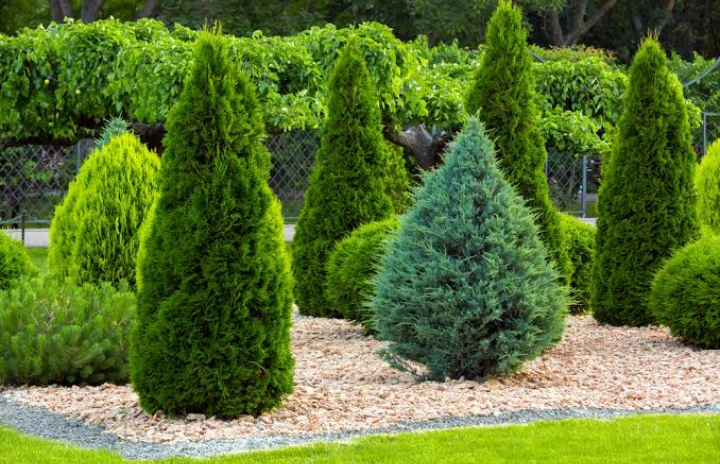
Arborvitae also referred to as Thuja is indeed a very beautiful plant and in North America it holds a special place in the hearts of many gardeners. It is loved by many as a front yard specimen due to its ability to be shaped into unique forms. The plant is also able to maintain its foliage nearly all the way to the base of the trunk year-round.
With arborvitae you may get a short 12-inch-tall shrub or a 30 feet tall tree. The leaves are scale-like and arranged in a flat plane, giving the plant a unique, layered look. This plant is often stunted or prostrate in less favorable locations. The foliage can be dark green to golden yellow in color.
Arborvitae are good in creating an aesthetic appeal to a front yard. When planting arborvitae in the front yard, it is important that they are spaced far enough apart to allow for proper air circulation and to prevent overcrowding. Once established in your front yard, the shrub can live for decades.
Facts And Data
| Scientific Name | Thuja orientalis |
| Native Area | Eastern Canada and United States |
| Size | 12 inches to 30 feet |
| Lifespan | 80 years |
| Seed Cones | Slender, Yellow green |
| Shape | Pyramidal |
| USDA Zones | 2 through 9 |
Colorado Blue Spruce
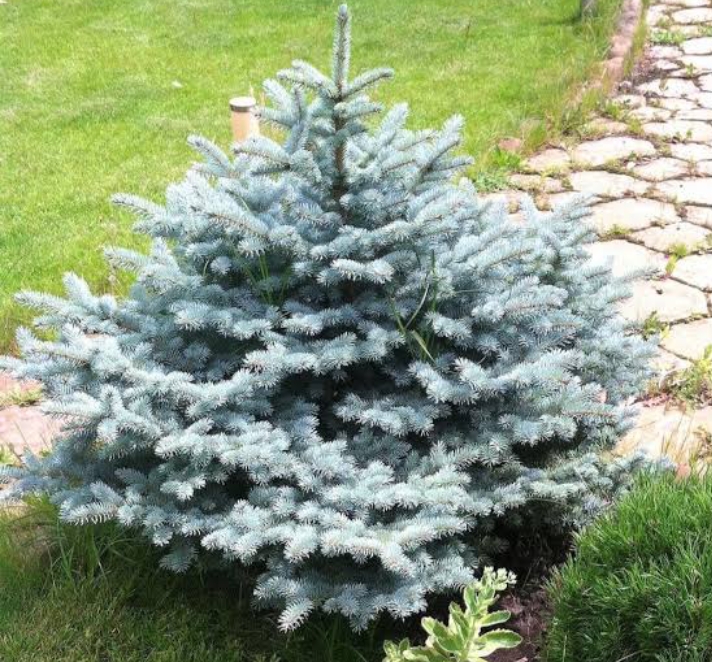
Colorado Spruce is considered by many in North America to be one of the best evergreen shrubs for front yards. Some of the reasons that account to its popularity are its striking blue-green needles, its conical shape and hardiness.
The needles are arranged in a spiral pattern around the stem and can be silvery blue or deep blue-green in color. This species of spruce is the state tree of both Colorado and Utah. It is found naturally in Arizona, Colorado, Idaho, New Mexico, Utah and Wyoming.
This plant can be trained to grow into a large tree or a shrub that stays under 10 feet. It can tolerate drought, heat and cold temperatures. It is also resistant to many pests and diseases.
When it comes to its shape, Colorado blue spruce grows in a beautiful conical shape and thus it can be a great focal point when grown in a front yard or front of the house. Moreover, it can be used as a Christmas tree or creating spiral shrub topiary and other shapes next to a front door.
Facts And Data
| Scientific Name | Picea pungens |
| Native Area | Rocky Mountains, South of Montana |
| USDA Zones | 2-8 |
| Height | 4 feet to 60 feet |
| Type | Coniferous |
| Bark | Grey with yellowish-brown branches |
Inkberry
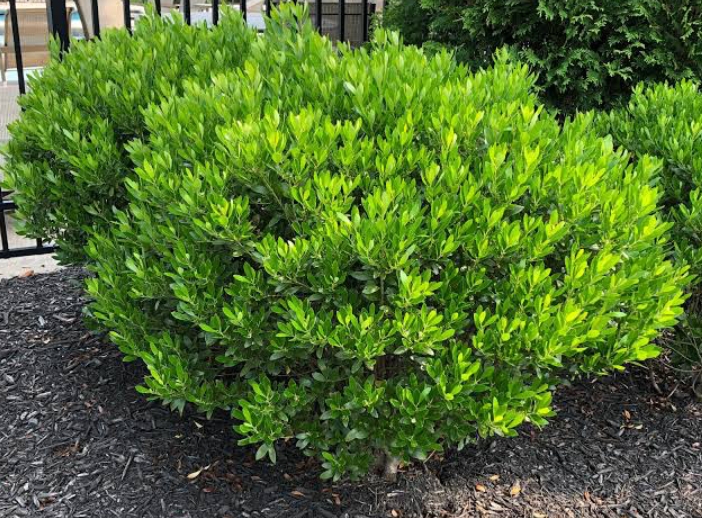
Inkberry also referred to as dye-leaves and gallberry is an evergreen shrub, can also be great for growing in the front of the house. This is large due to three main reasons: its dense foliage, adaptability and low maintenance requirements. It is often found in landscapes of the middle and lower East Coast of the United States.
The dark green leaves are small and oval-shaped, with a glossy texture. It is able to maintain this foliage throughout the year. Leaves usually remain attractively bright green in winter unless temperatures fall below -17◦F.
Inkberry is a very compact in nature, growing to a height of 3 to 6 feet. It can spread by root suckers to form colonies. It is actually good for smaller front yards or for planting in groups.
The shrub produces small white flowers in the spring, followed by black berries in the fall. Although the berries are not edible.
Inkberry is adaptable in the sense that, it can tolerate wet and dry soils, as well as sandy, loamy or clay soils. In front yards with varied soil conditions, this shrub is very ideal. It is also resistant to many pests and diseases.
Facts And Data
| Scientific Name | Llex glabra |
| Size | 5-8 feet |
| USDA Zones | 6-10 |
| Native Area | North America |
| Growth Habit | Spread by root suckers |
Mugo Pine
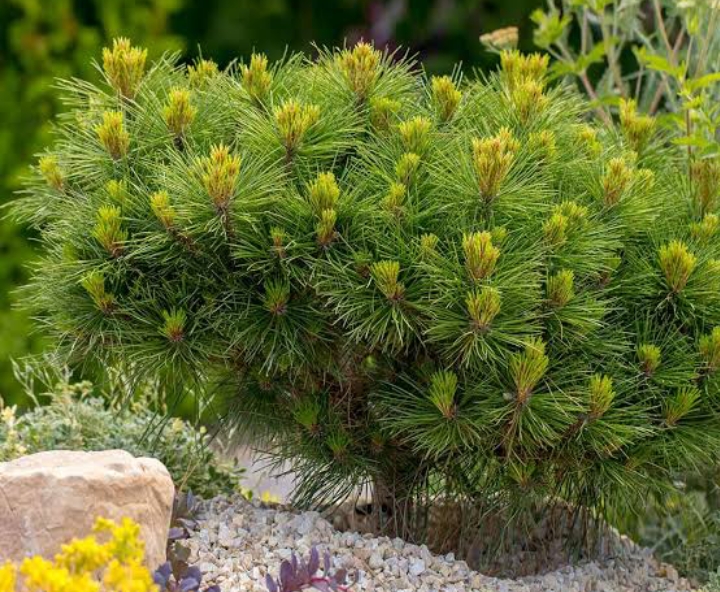
Mugo pine, also known as Bog pine or Creeping pine is actually a shrub or a small tree. It is a slow-growing in nature usually reaching a height of about 15 feet tall, though it can be trained as a shrub under 10 feet.
Mugo pine has a bushy growth habit, with densely packed needles and small round cones. The needles are dark green and are arranged in pairs along the branches.
Mugo is hardy in USDA zones 2-10. This means it can tolerate cold temperatures down to -50°F (-46°C). When compared to other shrubs and mugo can live for up to 100 years.
The best time to growing mugo pine in your front yard is in the early spring or fall, when the temperatures are cooler and there is typically more rainfall. This will allow the tree to establish a strong root system before the hot and dry summer months, which can be stressful for young plants.
Mugo pine can be used in different ways in front yard landscaping, including as a ground cover, as a border plant or as a specimen tree. It can also be grown in containers. In North America, it is often used in Japanese garden style and for larger bonsai specimens in front yards.
Facts and Data
| Scientific Name | Pinus mugo |
| Size | 5-15 feet |
| Growth Habit | Bushy, multi-stemmed |
| USDA Zones | 2-10 |
| Native Area | Central and South Europe |
| Type | Conifer |
Griselinia

Griselinia also referred to as New Zealand Private as an evergreen shrub is also good for small and large front yards. It is fast growing and will always feature fresh apple-green leaves, climbing or scandent branches.
Its apple-green foliage can provide an attractive backdrop for other plants and flowers in the front yard, and it can be easily shaped to suit a variety of landscaping styles.
The shrub can live for up to 50 years or more if they are well cared for. If they are planted in soil that is too wet or too dry or in an area that is too hot, they may not thrive and may have a shorter lifespan.
Griselinia shrubs are hardy in USDA zones 8 through 11. In USDA zone 8, Griselinia shrubs can tolerate winter temperatures down to 10 to 20 degrees Fahrenheit (-6 to -12 degrees Celsius). In zones 9 through 11, they can tolerate temperatures down to around 30 degrees Fahrenheit (-1 degree Celsius).
Griselinia shrubs can be used to create natural privacy screens, which can be important for front yards that are located close to the street or other homes. They can be planted as a hedge or used to create a living wall to block out unwanted noise, traffic or views.
Facts And Data
| Scientific Name | Griselinia lucida |
| Size | 3 to 7 feet |
| Growth Habit | Bushy |
| USDA Zones | 8-11 |
| Native Area | New Zealand and South America |
| Common use | Hedge plant |
Holly Bushes
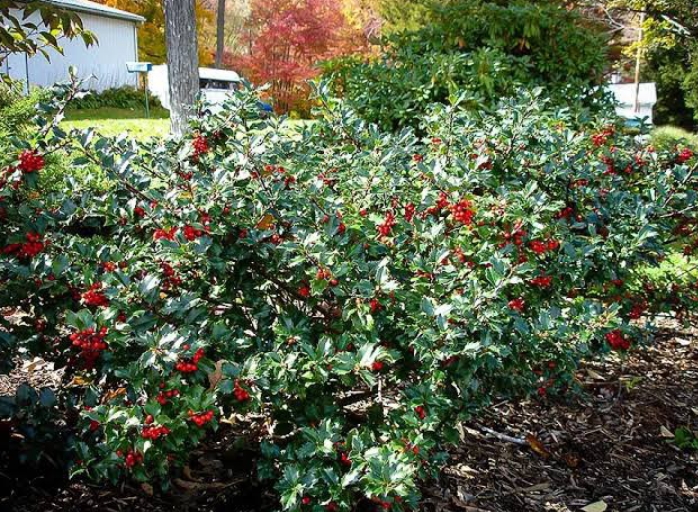
Holly shrubs are broadleaf evergreen in nature and actually iconic or best for front yards and backyards. The leaves of these shrubs are dark green and have a glossy, waxy texture. They are often spiny, with sharp, pointed tips.
Most holly shrubs will grow between 5 to 20 feet. They bloom in the spring or early summer. Berries are also produced in the fall and winter months, after the plant has been pollinated. They are often bright red or orange in color, but can also be yellow.
Most holly bushes are hardy in Zones 5 to 9, although there are some species that can tolerate colder or warmer temperatures.
When grown in a front yard or front of the house, holly bushes mainly serve as focal point, hedge or screen. They still can be grown in containers and moved easily around anywhere in the front house garden to serve various purposes.
Holly berries are poisonous in nature, therefore if you are growing them in front of your house, you will have to prune the berries from the parts of the bush that are within the reach of children.
Facts and Data
| Scientific Name | Ilex |
| Size | 3 to 10 feet |
| Growth Habit | Bushy |
| USDA Zones | 8-11 |
| Native Area | North America (United States) |
| Common use | Focal point |
Yew Shrubs
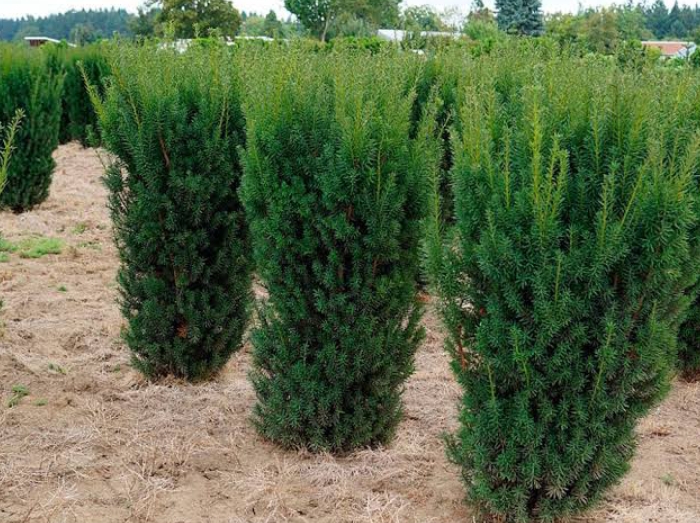
Yew can also be great for use in the front house yard. They are slow-growing, long-lived coniferous shrubs or small trees. Shrubby yews generally grow between 3 and 6 feet tall. The leaves are dark green, needle-like and arranged in a spiral pattern around the stems.
Most species of yew are hardy in Zones 5-8, although some cultivars may be hardy to Zone 4 or as far south as Zone 10. In a garden setting, the lifespan of a yew shrub is around 70 years.
In a front yard, yew shrubs can be pruned to any height or shape and can be used to create a formal or informal look. They can easily be pruned into many different shapes, including cones, globes and pyramids. Yews too work well when planted in groups with other shrubs or perennials.
Facts And Data
| Scientific Name | Taxus spp |
| Size | 3 to 6 feet |
| Growth Habit | Bushy |
| USDA Zones | 5-10 |
| Native Area | Europe, Asia, North Africa and North America |
| Common use | low hedges or foundation plantings |
Camellias

Camellias are a popular flowering evergreen shrubs throughout the world from North America to Asia. They are long-lived and low-maintenance shrubs that can be grown in different styles in a front yard. Its leaves are dark green with a leathery texture. Although other varieties have variegated or mottled leaves.
Camellias are generally early to mid-season bloomers, with many cultivars producing flowers from late winter through early spring. The blooms are often quite large. They can be pure white to deep red. In shape they can be single, semi-double or fully double.
Camellias can be used in different ways especially in a front house garden. It can be used as a specimen in mixed shrub borders or grown in containers for front house patios. They can also be used in lining walkways and driveways.
Facts And Data
| Scientific Name | Camellia |
| Size | 6 to 10 feet |
| Number of Species | 220 |
| USDA Zones | 7-10 |
| Native Area | Asia (Himalayas, Japan and Indonesia) |
| Common use | Focal points or specimen in mixed border |
Rose Mallow
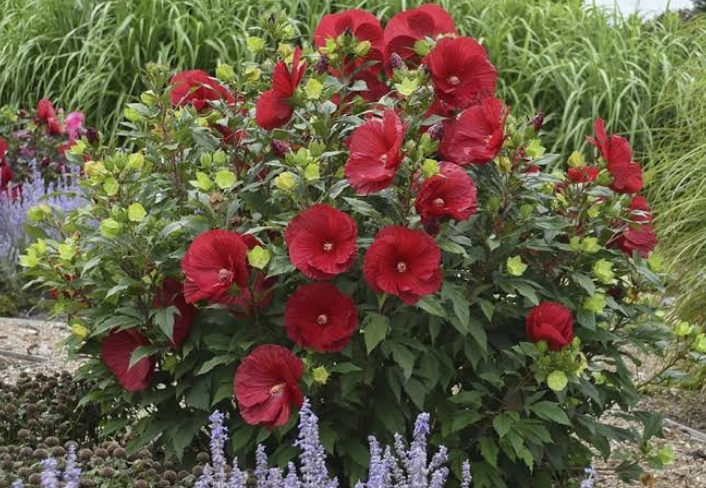
The Rose Mallow shrub may grow up to 10 feet tall but more often in places like United States, many gardeners train it to remain under 6 feet. The foliage is usually a deep green, which can provide a great backdrop to any other flowering plants you may want to add to your front yard.
It produces white, to red flowers with pinkish red eyes. These blooms appear in the summer and fall and can attract pollinators like bees and butterflies to your garden.
Rose Mallow can be planted as a single specimen plant or in groups to create a hedge or border in a front yard. It can also be mixed with other flowering plants in your front house garden.
Facts And Data
| Scientific Name | Hibiscus moscheutos (Hibiscus spp) |
| Size | 4 to 6 feet |
| Nature | Cold-hardy perennial |
| USDA Zones | 5-9 |
| Native Area | United States |
| Common use | Focal points or specimen in mixed border |